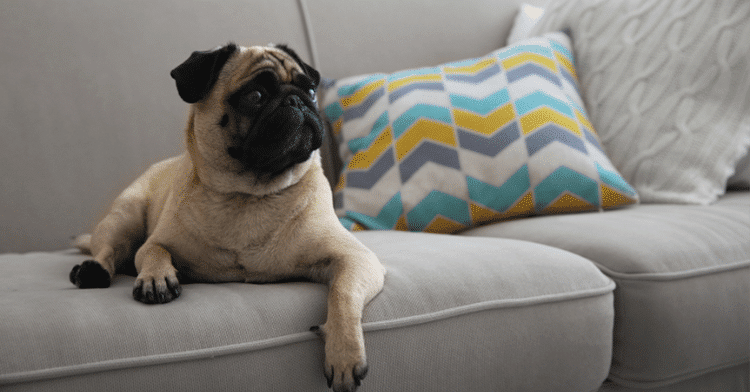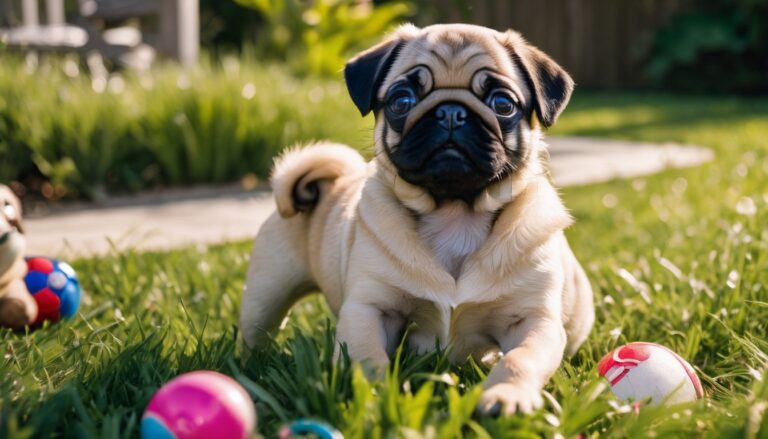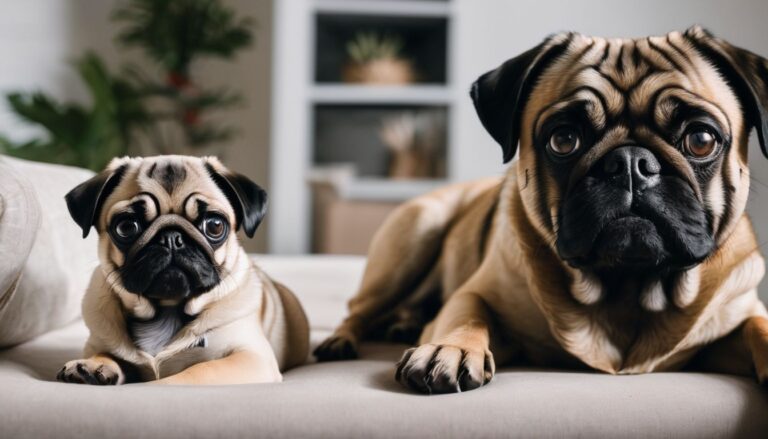The Ultimate Guide To Pug Training Tips: From Puppyhood To Adult Pugs
Pug Training Tips
Training a pug can often feel like you’re attempting to navigate an adorable maze of stubbornness. If you’ve found yourself nodding along, rest assured, you’re not alone on this journey.
That little furball with the big eyes isn’t just testing your patience; they’re teaching you perseverance. Studies advocate early training for these charming companions, and it’s advice worth taking.
Our guide is packed with step-by-step insights designed specifically for your playful friend, aiming to elevate them from that lovable mischief-maker at the park to a model of canine decorum.
Ready to turn those training challenges into triumphs? Let’s embark on this adventure together – after all, every great friendship takes a bit of work and a whole lot of treats!
Key Takeaways
- Start pug training as early as 8 weeks old with basic commands like “sit” and “stay,” and introduce housebreaking. Use treats for positive reinforcement and keep training sessions short to cater to their attention span.
- Consistency is vital in pug training, using the same commands and sticking to a schedule. This helps prevent confusion and reinforces good behavior, making routines easier for your pug to remember.
- Address unwanted behaviors by redirecting attention toward acceptable activities or toys. Avoid punishment, as it can lead to fear rather than learning; consistent positive reinforcement is more effective.
- Socialize your pug early by exposing them to various people, pets, and environments. This will help them grow into well-adjusted adults who are comfortable in different situations.
- For adult pugs, continue reinforcing previous training lessons while adjusting methods if necessary. Maintain patience since even older dogs can learn new behaviors through enjoyable and rewarding experiences.
Prerequisites for Training a Pug Puppy
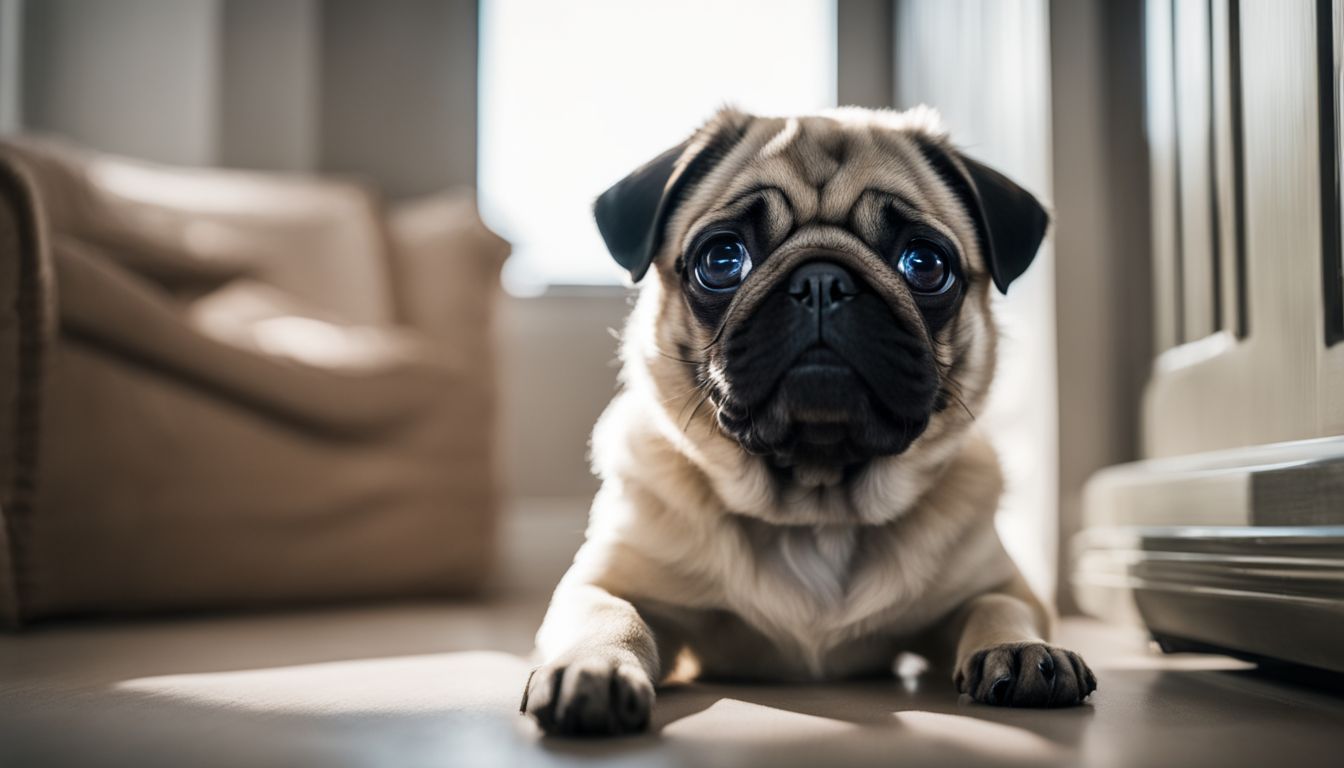
Before diving into the delightful journey of training your pug puppy, there are essential steps we need to take. Ensuring these prerequisites are in place sets the stage for a rewarding and effective training experience from day one.
What age can you start training a Pug puppy?
Starting to train your Pug puppy can begin as early as 8 weeks old. At this young age, they are capable of learning basic commands such as “sit,” “stay,” and “come.” This is also the prime time for house training and introducing your furry friend to a crate, which can become a comforting “den” for them.
Begin with short, positive training sessions that focus on praise and treats as rewards.
Socializing your pug pup during these formative weeks is crucial for their development. Exposure to different people, pets, and environments helps them grow into well-adjusted adults.
Keep each new experience pleasant and stress-free; we’re building confidence in our little companions! Remembering that patience is key will make all the difference – pugs love attention and respond well to encouragement over criticism.
What materials do you need for training?
Training your Pug doesn’t just happen by chance; it requires the right tools and materials. We’ve compiled a comprehensive list of essentials to set you on the path to success with your furry companion.
- A comfortable, size-appropriate collar to ensure control during training sessions. It should fit snugly without causing discomfort.
- A sturdy leash, around 4 to 6 feet in length, provides enough freedom while maintaining control.
- Training treats that are small and low – calorie work best as rewards during obedience exercises.
- A clicker, which serves as an auditory signal marking the exact moment your Pug performs correctly.
- Chew toys will be invaluable for redirecting biting behavior and keeping your Pug entertained.
- An appropriately – sized crate helps in establishing a routine and is essential for effective housebreaking.
- Potty pads or a litter box may be used for toilet training if outdoor access is limited.
- Grooming supplies including a brush, nail clippers, and toothbrush promote good hygiene and get your Pug used to handling.
- Safety gates can temporarily block off areas of the house until your Pug learns where they’re allowed.
- An exercise pen creates a safe area for your Pug to play in while you’re not able to closely supervise them.
Key considerations for potty training
Potty training a pug puppy requires patience and consistency. Start by setting up a designated bathroom area and take your pup there regularly, especially after meals or naps. Use positive reinforcement every time your pug does its business in the right spot—treats and praise work wonders.
Accidents will happen; stay calm and never punish your pet for slip-ups.
Stick to a schedule as much as possible to create a routine for your little friend. Pugs catch on quickly when they know what’s expected of them. Keep an eye out for signs that they need to go, like sniffing around or circling, and immediately guide them to their potty area.
With these considerations in mind, you’ll have a well-trained companion before you know it!
Understanding Pugs and Their Behavior
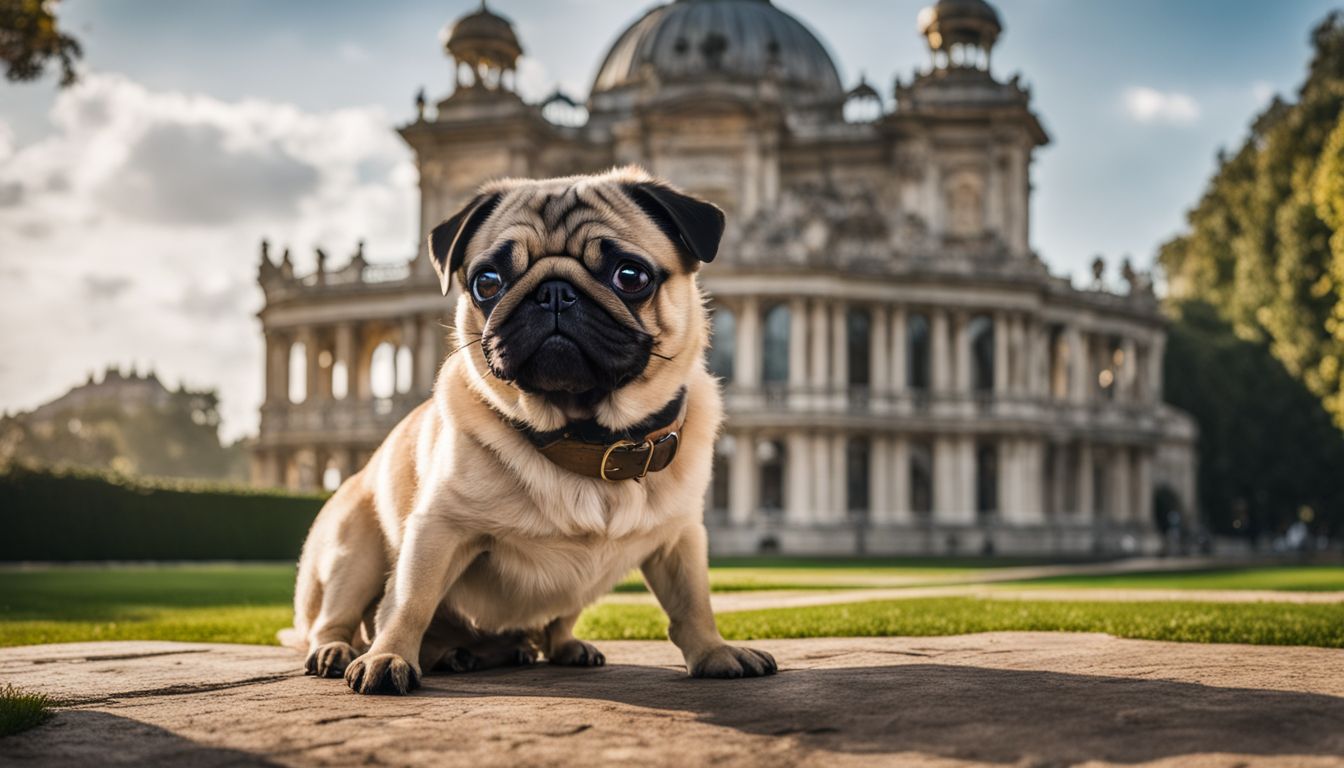
Understanding the unique quirks and characteristics of Pugs is essential in tailoring an effective training program. These affectionate companions, originally bred as lapdogs for Chinese royalty, exhibit behaviors rooted in their history which can influence their learning process.
Origin and purpose of the Pug breed
Pugs hail from ancient China where they served as cherished companions to royalty, a tradition that continues today with their status as beloved lapdogs. Their adorable features and affectionate nature were cultivated over centuries to win the hearts of emperors and nobles alike.
These little dogs weren’t just for show; they played an important role in their owners’ lives, offering not only companionship but also a touch of luxury and prestige.
Our furry friends are well-suited for dog lovers who seek a pet capable of strong bonds and full of personality. Pugs thrive on human interaction, making them ideal candidates for those desiring a dog eager to participate in family activities.
Now let’s dive into how their storied past influences the way we approach pug training today, ensuring these four-legged jesters live up to their potential as elite companions in both spirit and manners.
How their background impacts their training
Pugs come from a lineage that was bred to be companions, which shapes their personality and responsiveness to training. They are eager to please their owners but can also have a stubborn streak due to their royal past where they were pampered and not given strict rules.
We recognize these traits, knowing this insight is crucial as we tailor our methods for pug training. Our approach uses engaging techniques that leverage the pug’s natural desire for attention and affection while gently enforcing discipline.
Our pug puppies respond best when training sessions are short, fun, and rewarding. With patience and positive reinforcement, they quickly learn the ropes of basic obedience training.
Understanding the importance of early socialization helps us introduce new experiences in a positive light so our pups grow up confident and adaptable. We focus on creating an environment where learning is comfortable yet assertive – avoiding harsh corrections as it could damage the trust between us and our furry friends.
Overview of the Pug training program and topics covered
Understanding the unique background of pugs, we’re ready to dive into the specifics of our training program, designed to cater specifically to their distinct needs. Our comprehensive guide outlines a structured approach that covers everything from essential obedience commands like ‘sit,’ ‘stay,’ ‘come,’ to more advanced tricks that can help stimulate their minds and reinforce good behavior.
We cover crucial topics such as socialization, which is key for helping pugs become well-adjusted adults comfortable around new people and environments.
We also tackle common behavioral challenges faced by pug owners. Addressing issues like stubbornness and biting early on is vital, employing patience and consistency in our methods.
The program includes strategies for effective toilet training – a concern many owners are familiar with – ensuring your pug develops good habits from the start. Throughout our program, we use positive reinforcement techniques, rewarding desirable behaviors to encourage your pug’s learning while building a loving bond between you both.
Building a Successful Pug Training Program
In shaping your Pug’s behavior, embracing consistency and positive reinforcement leads the way to a harmonious household—discover our step-by-step approach for an effective training regimen that suits this charming breed.
Importance of consistency and positive reinforcement
Training our pugs demands both consistency and positive reinforcement. By sticking to a regular schedule, using the same words for commands, and maintaining uniform rules, we help our furry friends understand what behaviors are expected of them.
Consistency in training sessions and in our reactions to their actions is crucial; it allows pugs to learn faster by forming clear associations between cues and actions.
Rewarding good behavior with treats, praise, or playtime reinforces those actions we want to see more of from our pugs. Positive reinforcement not only encourages them but also strengthens the bond between us as dog owners and our adorable companions.
It’s about rewarding them immediately after they do something right so that they associate that good feeling with the behavior. This approach steers clear of punishment which can lead to fear or aggression, instead promoting a loving environment where learning is fun and rewarding for everyone involved.
Using the “Push Drop Stick” method
We’ve discovered that the “Push Drop Stick” method works wonders for teaching our pugs new tricks. This approach is all about guiding your dog through steps of a command until they comprehend what you’re asking for.
First, you ‘push’ by gently guiding them into position – think showing them how to sit by pressing down on their back end. Once they’re in place, give a firm ‘drop’ command and reward them as soon as they comply.
Let’s stick with this method together to build a strong foundation for our furry friends. After mastering the initial step, we continue with the term ‘stick’, which means reinforcing the behavior until it becomes second nature to them.
Consistency is key here; always use the same word or hand signal so your pug understands exactly what you expect each time. With patience and repetition, these lovable dogs will amaze us by how quickly they learn.
Up next, we’ll dive into our week-by-week training guide for pug puppies, ensuring each milestone is met with enthusiasm and success!
Week-by-Week Training Guide for Pug Puppies
Our comprehensive week-by-week guide offers a structured approach to training your Pug puppy, ensuring that each phase of their development is met with the right learning opportunities; stay tuned for an insightful journey into shaping your pup’s behavior.
Week 1: Sleep, Alone, Toilet, and Socialization Training
Training a Pug puppy requires dedication from the very first week. Let’s start with the foundation: sleep, alone time, toilet habits, and socialization.
- Establish a regular sleep routine by setting up a cozy bed in a quiet spot where your Pug can snooze without disturbances.
- Introduce a crate as a safe space for your puppy to learn that it’s okay to be alone for short periods.
- Begin potty training immediately; take your Pug outside regularly and praise them when they do their business.
- Keep nighttime outings calm and quiet so that your Pug associates outdoors with toileting, not playtime at night.
- Schedule nap times after meals and play sessions to help your puppy understand the daily rhythm in your home.
- Provide comfort items like toys or an old shirt with your scent to soothe your puppy when they’re alone in the crate.
- Use consistent cues such as “bedtime” or “quiet time” to signal it’s time to settle down for rest or solitude.
- Ensure everyone in the household follows the same potty – break schedule to avoid confusion for your pup.
- Positive reinforcement is key; reward good behavior with treats or affection during toilet training and when they stay calm while alone.
- Socialize your Pug by gently introducing them to various sounds, surfaces, and experiences around the house.
Week 2: Training Tasks
Welcome, fellow Pug Lovers! It’s week two, and our pug puppies are ready to tackle new training tasks. This stage is crucial as we lay the foundation for obedience and good behavior that will last a lifetime.
- Introduce your pug to its name by consistently using it before giving commands or during playtime.
- Start with basic commands like “sit”, “stay”, and “come”. Use clear, simple instructions and reward immediately with treats for success.
- Encourage your pug to walk nicely on a leash without pulling. Keep first walks short and sweet to maintain their attention.
- Teach the “leave it” command to help prevent unwanted behaviors like chewing on objects or picking up dangerous items.
- Begin crate training for comfort and safety during times when supervision isn’t possible. Make the crate inviting with blankets and toys.
- Practice handling by gently touching your pug’s paws, ears, and mouth. This prepares them for grooming and vet visits.
- Address biting behavior by redirecting them to chew toys instead of hands or furniture.
- Create a consistent schedule for feeding, playing, and toilet breaks to establish routine and reduce anxiety.
- Incorporate short sessions of separation from you within the home to ease into alone time gradually.
Week 3-8: Continued Training and Milestones
As our pug puppies grow, so does their capacity for learning new commands and behaviors. From weeks 3 through 8, we focus on reinforcing what they’ve learned and introducing more complex tasks.
- Introduce the “sit” command in week 3, starting with short training sessions.
- Practice the “stay” command as your pug masters sitting still; reward immediately after following through.
- Begin leash training by letting your pug wear a collar and walk around indoors.
- Encourage polite behavior when meeting new people or pets to foster good social skills.
- Increase the duration of “sit” and “stay,” building patience and self-control in your pet.
- Initiate crate training to provide a safe space for your pug; start with short periods.
- Begin simple recall training using treats, ensuring your pug comes when called.
- Add obstacles to walking paths to boost agility and confidence during playtime.
- Teach the “down” command, rewarding your pug for lying down upon request.
Pug Training Tips
Diving into the heart of pug education, we uncover the golden rules for sculpting obedient and happy companions. Learn to navigate their stubborn streaks with ease, transforming training from a chore into a bonding journey for both of you.
Focus on basic obedience and house training
Training your Pug starts with mastering basic obedience and house training. We teach them commands like “sit,” “stay,” and “come” to ensure they understand fundamental directions that will keep them safe and well-mannered.
These simple instructions form the foundation for more advanced training later on. House training is equally important; it’s all about setting a routine, using positive reinforcement when they do their business in the right place, and being patient as they learn.
It’s key to establish these behaviors early on to prevent future issues such as separation anxiety or unwanted barking. Using treats and lots of praise works wonders in reinforcing good habits during these initial stages.
Remember, we’re not just training our pugs; we’re building a bond of trust and understanding that will last their entire lives.
Using clear and simple commands
We know that pugs can be a bit stubborn, but they respond well to clarity and simplicity. To get the best out of our little companions, we use commands that are short and straightforward—think “sit,” “stay,” “come,” and “no.” These one-word instructions leave no room for confusion and help our pugs understand exactly what we expect from them.
It’s important to use a firm yet cheerful tone to keep their attention focused on us.
Consistency is key in reinforcing these commands; every member of the household must use the same words for each action. This ensures your pug won’t hear mixed messages and will learn quicker.
Just like with people, first impressions stick, so let’s make sure our furry friends’ introduction to obedience is smooth sailing. Now, let’s dive into how redirecting unwanted behaviors can enhance your training efforts even further.
Redirecting unwanted behaviors
Redirecting unwanted behaviors in Pugs can be quite a challenge, but we’ve got strategies that really work. Start by catching your Pug in the act of an undesired behavior and immediately redirect their attention to a more appropriate activity.
Offer a favorite toy or initiate a game as an alternative, turning their focus away from mischief. Consistent redirection not only prevents bad habits from taking root but also teaches your furry friend what’s expected of them.
Ensure you have treats on hand to reward positive behavior promptly. This timely reinforcement helps your Pug understand which actions please you the most. Keep training sessions short and sweet, so they don’t lose interest or become frustrated.
By maintaining patience and perseverance, even adult pugs can learn to replace old habits with new, preferable ones.
Our next topic will delve into the importance of consistency when training adult Pugs..
Training Adult Pugs
When it comes to training adult Pugs, we can’t emphasize enough the importance of sticking with a routine that incorporates positive reinforcement. It’s all about building on the foundation laid during their puppy years and adjusting strategies as they mature, making sure training remains an enjoyable experience for both you and your furry companion.
Importance of consistent training
Training our pugs consistently sets the foundation for their lifelong behavior and obedience. Consistent training helps prevent confusion, as pugs learn to associate specific commands with expected actions.
We commit to regular sessions that build on previous lessons; this way, these lovable dogs understand what’s expected of them every day. Repeating exercises reinforces their learning and enhances memory retention, making commands second nature over time.
Our dedication to persistently training our furry friends shapes responsible habits and curbs undesirable behaviors. By adhering to a steady routine, we foster trust between us and our pugs, crucial for a harmonious living environment.
As we move forward with patience and commitment in training adult pugs or puppies alike, let’s gear up for positive reinforcement without resorting to punishment in the next section: “Using positive reinforcement and avoiding punishment.”.
Using positive reinforcement and avoiding punishment
Consistent training lays the foundation for a trusting relationship with your Pug, but it’s positive reinforcement that truly unlocks their potential. Shower them with praise and treats every time they get something right.
This encourages them to repeat those good behaviors because they associate them with happy outcomes. Keep training sessions fun and rewarding; this way, your furry friend will always be excited to learn.
Avoid using punishment as a tool in your training arsenal—negative methods can lead to fear and anxiety, which undermines trust between you and your Pug. If they make a mistake or don’t follow a command, stay patient and guide them gently towards the desired action.
Consistency is key here too; always respond the same way so they learn what’s expected of them without any confusion or distress stirring up in their minds.
Pug Training Tips Conclusion
Training your pug, whether a bouncy puppy or a dignified adult, can be an enjoyable journey for both of you. We’ve armed you with strategies and insights that cater to the unique characteristics of this lovable breed.
Remember to approach each session with patience and positivity. Keep the treats handy and your expectations realistic as you embark on this adventure together. Let’s turn your pug into the best companion they can be!
Pug Training Tips FAQs
In our journey together training our beloved pugs, we’ve encountered a variety of questions that you might also have on your mind. Let’s dive into those queries and arm ourselves with the knowledge to foster a happy, well-behaved furry friend!
Addressing common concerns about Pug training
Many pug lovers worry that their furry friends are too stubborn for training, but we’ve found patience and understanding go a long way. These compact dogs may have a strong-willed nature, yet with consistent positive reinforcement, they can learn just like any other breed.
Start them early to establish good habits, and remember that socialization is key; exposing your pug to various environments helps build confidence and ease during training.
Sometimes owners question if it’s too late to train an adult pug—rest assured it isn’t. While starting in puppyhood offers a great foundation, older pugs are capable of learning new tricks and behaviors as well.
It takes time and commitment, but progress will show through perseverance and dedication to regular practice sessions. Keep the sessions short to align with their attention span; soon you’ll see your efforts reflect in their obedience.
Moving forward from common concerns about training methods, let’s now delve into tips for cleaning Pug’s ears—a crucial aspect of keeping your pet healthy alongside behavior training.
Additional resources for professional training and veterinary advice.
For those of us committed to raising happy and well-behaved pugs, there are plenty of excellent resources available. Dog obedience classes can be a great way to teach your pug new tricks and behaviors while under the guidance of a professional dog trainer.
If you’re looking for more specific advice or if your pug is facing unique challenges, consulting with a certified behaviorist could provide personalized strategies that cater to their needs.
Sometimes our furry friends encounter health issues or we might have questions about their overall wellbeing. In such instances, it’s crucial to turn to experienced veterinarians who understand the peculiarities of brachycephalic breeds like pugs.
What are the first steps in training a pug puppy?
Begin your pug’s training journey by establishing routine dental care, introducing simple commands, and consistently practicing gentle dog behavior reinforcement from early puppyhood.
How can I research effective training techniques for my pug?
You can look up reliable sources like the American Kennel Club or consult professional dog trainers who specialize in small breeds like pugs to understand their specific needs.
Can social media platforms help with pug training?
Yes, social media platforms often have communities of pug owners where you can share tips, watch training videos, and get advice on how to handle things like a pug’s unique personality.
Are there any special considerations for adult pugs when it comes to training?
For adult pugs who might be set in their ways, patience is key. Use positive reinforcement and adapt your approach based on their established dog behavior patterns.


